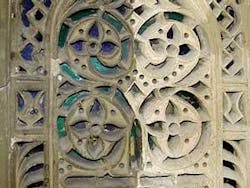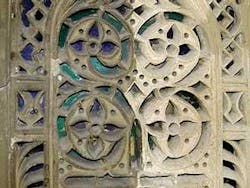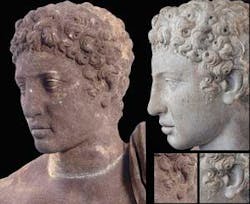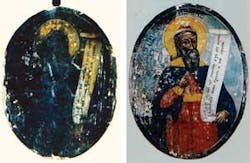Clean art
High-power lasers are used to clean the surfaces of marble antiquities, painted artworks, and ship hulls
M. Farsari, P. Pouli, G. Totou, V. Zafiropulos, C. Kalpouzos, and C. Fotakis
Laser ablation has been widely employed to remove unwanted layers in a variety of surfaces. It has proved to be a particularly useful method in the cleaning of antiquities1,2 and painted artworks;1,2,3 the application relies on the strong absorption of the layers to be removed, while there is minimal penetration of the underlying layers. The ablation depth can be monitored extremely accurately using spectroscopic techniques. Laser techniques developed by our laboratory are currently used to clean unique antiquities and artworks.
Another area where laser cleaning might prove useful is the cleaning of ship hulls.4,5 Because of damage to the paint of the ships, they have to be repaired regularly. This is done by placing the ship on a dry dock, stripping all the paint from it using chemical methods, and repainting the ship. This is a time consuming, expensive process, with high environmental cost and unhealthy conditions for the workers. Our laboratory is investigating the automated repair of the paint damage on ship hulls using high-power lasers. A series of various power lasers in the infrared and the UV have been investigated for the spot removal of damaged paint, with very encouraging results. The laser cleaning method, as it removes only the damaged paint, has the advantage of being faster and requiring only limited re-painting, therefore lowering both the financial and environmental cost. And as it is done remotely and without the use of hazardous chemicals, it does not endanger the health of the workers.
Cleaning of marble antiquities
The exposure of marble antiquities to environmental conditions results in the development of a superficial layer, commonly referred to as ‘encrustations.’ Such encrustations are
- Soil-dust deposits found on artworks excavated or located among ruins. They are rich in carbonates, aluminosilicates and various reddish-brown ferrous oxides.
- Black Dendritic accumulation encrustations developed in areas sheltered from rain, consisting mainly of gypsum, calcite, silicates, black micro-particles, deposits of dust, soot etc.
In the cleaning of stone artworks, there are two major requirements: the removal of encrustations, to maintain the original appearance of the artwork and prolong its lifetime, and the preservation of the original surface, to enhance the carved details.
Traditionally, marble artworks are cleaned using chemical or mechanical means. However, these processes have a low degree of controllability and have in the past resulted in damaging the artwork. In comparison, laser cleaning offers control and selectivity through the phenomenon of self-limiting, in which the ablation threshold of the encrustation is significantly lower than that of the marble substrate at the fundamental wavelength of Nd:YAG lasers.6 Pulsed output from a Nd:YAG laser can safely remove thin layers of black encrustations on stone by first generating a plasma near the surface, then ablating and vaporizing the polluting layer. Subsequent pulses on the same area are diffusely reflected from the clean stone. This is clearly demonstrated in Figure 1, where the ablation thresholds of the marble and the encrustation are shown.
To demonstrate the successful application of laser cleaning on ancient marble, Figure 2 shows details of an ancient statue before and after laser cleaning. 7 The statue is Hermes of Ancient Messene, an oversized sculpture of the 1st Century AD found at the excavation site of Ancient Messene in Peloponesse, Greece, in 1996, by Prof. P. Themelis.
The analysis carried out by XRD and SEM-EDX showed that the crust was carbonatic and rich in aluminocilicates. No gypsum was detected, while its characteristic reddish brown color was found to be due to various ferrous oxides. Petrographic analysis was carried out to find the relationship of the crust with the marble substrate, and to correlate the adhesion of the crust with the condition of the marble surface. It was found that at the areas where the material was sound-the parts of the statue that were buried face down-the crust formed on the surface with good adhesion to the substrate reaching 2-3 mm in thickness. At areas suffering from sugaring-the parts of the statue laying face up-the crust was thin with penetration in exposed inter-crystalline spaces. Currently our laboratory is laser cleaning a series of ancient monuments, including the West Parthenon Frieze blocks.8
Cleaning of paintings
The majority of painted artifacts is covered by a varnish layer (typically 50-80 µm thick) in order to protect the original painted surface as well as to enhance its color. This varnish is prone to natural aging (polymerization and photo-oxidation) resulting in a dark, hard superficial film. In addition, external pollutants such as dust, soot, candle smoke (in the case of ecclesiastical paintings), and dirt in general may contribute to the obstruction of the original colors and the distortion the artist’s vision of the artwork.
The removal of these superficial layers is a complex and risky procedure. The following requirements must be fulfilled: cleaning of the pictorial surface and its support material from dirt and photodegradation products and elimination of any over-paintings that might exist. Again, the traditional conservation methods employ mechanical and chemical means. They are particularly difficult to control methods however; mechanical means might lead to removal of material from the artwork, while the chemicals could penetrate the artwork and damage the pigments. Both methods could cause irreversible damage to the artwork.
In comparison, laser cleaning offers a great degree of selectivity and controllability. It is done using UV excimer lasers asthe substrate is highly absorbing in the ultraviolet. This way, both the ablation is at its most efficient and material removal is maximum, and the light penetration to sub-layers is minimal. The thickness of the removed layer per pulse can be 0.1-1 µm and can be very accurately controlled using techniques such as multi-spectral imaging and Laser-Induced Breakdown Spectroscopy (LIBS).
To demonstrate the successful application of laser cleaning on a painting, Figure 3 shows pictures of a Byzantine icon before and after laser cleaning. This is a fully weathered 17th century icon of the Prophet Isaiah, from Mount Athos. The icon was in such a fragile state that any mechanical or chemical means for its conservation were deemed inappropriate.
The successful cleaning of this icon has led to further research into laser cleaning of paintings, and several world-renown artworks have been treated in our laboratory.
Cleaning of ship hulls
Damage to the paint of ships requires that they be repaired regularly. The cleaning of ships does not require the same level of accuracy and controllability as the cleaning of antiquities and paintings; it is, however, a very active research area, as there is a requirement to reduce both the financial and environmental cost of ship hull repairing. Laser cleaning is a promising method, as it removes only the damaged paint, lowering both the financial and environmental cost.
In the course of researching laser ship hull cleaning, the following lasers, covering a range of IR, visible, and UV wavelengths, were investigated:
- a free-running Nd:YAG laser operating at the fundamental wavelength of 1064 nm and with pulsewidth in the microseconds
- a Q-switched Nd:YAG laser operating at the fundamental wavelength of 1064 nm and the third harmonic of 355 nm (both together and separately). The pulsewidth is in the nanoseconds
- an up to 200Hz excimer laser operating at a wavelength of 248 nm and a pulsewidth in the nanoseconds.
The ablation depths per Joule are shown in Figure 4. Unsurprisingly, the most promising wavelength appears to be 248 nm. However, there are several financial and logistical issues involved in obtaining a high-repetition, high-power excimer laser and delivering its beam in a ship hull. When the beam delivery and cost are taken into account the Q-switched Nd:YAG appears to be a more practical option.
Conclusion
In this paper, we have presented some of the work carried out in our laboratory in the field of laser cleaning, the main applications being the restoration and conservation of antiquities and artworks and ship maintenance. We have also shown that the most appropriate laser for cleaning and restoring marble is the pulsed Nd:YAG laser operating at the fundamental wavelength, while the most appropriate lasers for cleaning and restoring paintings are UV excimer lasers. We have also shown that the most appropriate but generally impractical laser for ship-hull cleaning is a UV excimer laser; however, an IR Nd:YAG is a more feasible option.
The authors are with the Institute of Electronic Structure and Laser, Foundation for Research and Technology-Hellas, Heraklion, Crete, Greece. Contact: [email protected].
References
- M.I. Cooper, Laser Cleaning in Conservation: an Introduction, (Butterworth Heinemann) 1998.
- Laser Cleaning, Ed. B. Luk’yanchuk (World Scientific, 2002) Ch. 8, pp. 337-386.
- S. Georgiou et al./Applied Surface Science 127-129 (1998) 728-745.
- W. M. Steel, J. Opt. A: Pure Appl. Opt. 5 (2003) S3-S7.
- A. Tsunemi et al., Appl. Phys. A, 63 (1996) 435-439.
- P. Maravelaki-Kalaitzaki et al./Applied Surface Science 148 (1999) 92-104.
- The preliminary study and the laser cleaning was a collaborative work between IESL-FORTH and a private stone conservation company based in Athens, Greece. (Lithou Sintirissis, Y. Dogani, and A. Galanou).
- P. Pouli et al., LACONA V proceedings, Springer-Verlag, 2004 (in press).





